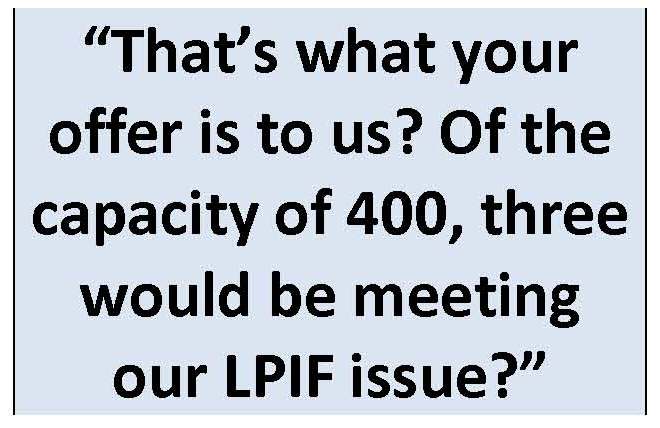
GATINEAU – Bell TV and Shaw Direct used the rebuttal phase of the CRTC’s Direct-to-Home (DTH) policy hearing to make new proposals in hopes of showing good faith to the Commission and Canadian broadcasters that they are willing to do more to carry local over-the-air (OTA) signals.
On Thursday, Shaw proposed to add six virtual channels in MPEG4 by August 31, 2011. To do this, the company will upgrade a transponder to MPEG4, which requires it to drop eight full-time channels. The addition of virtual channels would require Commission approval.
Jean Brazeau, Shaw Communications’ senior VP of regulatory affairs, noted that the channels would appear in the program guide as if they were the local channel. “These virtual channels would have a discrete and permanent presence in our programming guide and be identified as the local station,” he said.
Under questioning it came to light that some of the bandwidth made available from the transponder upgrade would actually be used to satisfy carriage requirements laid out in CRTC 2008-100 and would only be partially available for uncarried local OTA stations.
Gary Pizante, Shaw Direct’s VP of corporate affairs, provided clarification on how the company’s plan will work. Some of the bandwidth made available through the dropping of eight channels and the upgrade of the transponder to MPEG4 would be used to launch seven or eight channels required under 2008-100 with the remaining bandwidth used to distribute a few OTA channels, he explained.

Shaw also got a rough ride from commissioner Candace Molnar on the company’s plan to only make three additional virtual channels available for local OTA stations on its Anik G1 satellite, which will launch next November. She questioned Shaw’s plan to add three more channels when the satellite has 16 transponders capable of carrying 100 HD channels (parties disagreed on how many SD channels could fit on G1 with estimates ranging from 300 to 400).
“That’s what your offer is to us? Of the capacity of 400, three would be meeting our LPIF (Local Programming Improvement Fund) issue?” she asked Shaw.
“Yes, for this specific purpose that’s what we’re proposing,” responded Brazeau. “But going forward of course, we’ll be adding more specialties, even locals also. It’s just natural.”
Molnar pressed Shaw on the issue, noting that “to hear that three of a potential capacity of 400 would be targeted to meeting that objective is a little bit disappointing to be honest.”
Said Pizante: “I get it, three doesn’t sound like a lot, but when you add [them] on top of 2008-100, and you add [them] on top of the category “A”s we have to do…I think we’re getting close to 100 channels. And we want to have flexibility to respond to the marketplace in terms of HD and 3D services, and things like that.”
For its part, Bell TV said it’s prepared to distribute an additional five LPIF-eligible OTA stations not currently carried if the broadcasters agree to partial or omnibus distribution in the near term until the company has additional capacity to switch them over to full-time carriage.
“While not a perfect solution, this is a positive interim step towards full carriage, and would deliver all unique local programming from all LPIF-eligible stations to our customers in those communities,” Mirko Bibic, Bell senior VP of regulatory and government affairs, said in his opening remarks. “We encourage OTA broadcasters to move forward on this matter.”
While Bell put the partial carriage solution on the table, it prefers to go with the omnibus approach. In response a question from chair Konrad von Finckenstein, Heather Tulk, senior VP of residential products explained why the omnibus channel is better for both the DTH distributor and the broadcaster.
The broadcaster would choose the programming from uncarried signals it wants included on the station, it would set the schedule and input into the electronic programming guide. And just like a viewer would be able to see that Mad Men is being broadcast at a certain time on a certain day, the viewer would be able to see the schedule for the various local programs, said Tulk. She added that each omnibus station would be from a single broadcast group.
As well, it would be up to each major broadcast group to determine which programming is live and which is from tape as opposed to the partial distribution scenario where it would be up to the DTH distributor to make those decisions.

“That’s why we believe the omnibus [approach] is much cleaner because it’s up to the [broadcast groups to make choices for themselves], rather than us trying to navigate which one of these eight contenders gets the five spaces we might have available.”
FreeHD Canada, which kicked off the rebuttal phase, noted that partial or omnibus distribution isn’t the solution. “Omnibus and partial channel solutions are nothing more than a temporary band-aid on a gaping wound,” said company founder and CEO David Lewis, noting that the only real solution will come from capacity upgrades.
He said Bell could employ unused Ka-band capacity in Nimiq 4 to distribute all uncarried local OTA stations as was the case in its Freesat proposal. Alternatively, it could upgrade one transponder to MPEG4, giving it the ability to distribute all remaining LPIF-conforming stations. For Shaw, the company could also upgrade a transponder to MPEG4, giving it the ability to carry a significant portion of the LPIF stations it currently doesn’t distribute, Lewis added.
“In the longer-term, the wholesale migration to MPEG4 should be a business imperative for all DTH operators or they will not have sufficient capacity to migrate their services to HD and remain competitive,” stated Lewis.


